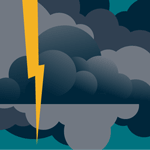
Ten years ago, the costliest severe thunderstorm outbreak to strike Europe since the 1984 Munich hailstorm began. Dubbed Hilal, it lasted a full week, impacted mostly southwestern Germany, caused between EUR 800 million and EUR 1 billion in insured losses (from hail, straight-line wind, and flood), according to various industry sources. Given the loss history of severe thunderstorms in the impacted area, companies managing their severe thunderstorm risk by the traditional method of looking at the historical record might have been caught by surprise by the magnitude of the losses.
Because of the localized nature of individual hailstorms and straight-line winds—the sub-perils responsible for the most significant losses from European severe thunderstorms—using historical losses for risk assessment and management is not sufficient. According to the soon-to-be-released AIR Severe Thunderstorm Model for Europe, convective storms across the model domain of 22 countries account for 40% of insured losses from the atmospheric perils of severe thunderstorms and extratropical cyclones, on average. Thus, for a complete view of European atmospheric peril risk, companies need to understand and actively manage their severe thunderstorm risk.
